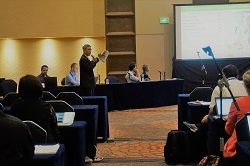Managing tropical forest biodiversity across international borders
9 December 2016

Mr Chheang Dany, Cambodian Forest Administration, delivers his presentation at the ITTO-CBD-BirdLife International side-event at CBD COP13. Photo: S. Lim
Many tropical forests rich in biodiversity straddle international borders, but conserving these forests and enabling local and indigenous communities with shared origins and cultures to interact across such borders has proved challenging.
The outcomes and lessons learned in projects the Emerald Triangle Protected Forests Complex (ETPFC) shared by Thailand, Cambodia and the Lao People’s Democratic Republic and in the Greater Gola Landscape between Liberia and Sierra Leone were presented at a side-event organized jointly by ITTO, CBD and BirdLife International. The side-event, which was held on 8 December 2016, was titled “Borderless conservation in a borderless world: Efforts of countries to conserve tropical forest biodiversity in transboundary areas”. The presentations showed how international cooperation was essential for the sustainable management of transboundary forest areas and the protection of the biodiversity contained in them, while also helping local people maintain cultural links across borders.
On behalf of Cambodia’s Forest Administration, Mr Chheang Dany presented the outcomes of the ITTO-funded project PD 577/10 Rev.1 (F): “Management of the ETPFC to promote cooperation for transboundary biodiversity conservation between Thailand, Cambodia and Lao People’s Democratic Republic (Phase III)”. The ETPFC covers an area of 653 400 hectares and is one of the most important biodiversity conservation corridors of the greater Mekong subregion, offering refuge to 50 wildlife species on the IUCN Red List, including ten critically endangered species. The project has strengthened the protection of the transboundary area through joint monitoring, capacity building and research, empowered local communities, and improved livelihoods.
Mr Pepe Clarke, Head of Policy, BirdLife International, informed side-event participants that the Greater Gola Landscape is a transboundary mosaic covering 300 000 hectares of protected and community-managed forests between Sierra Leone and Liberia. It is a hotspot of biodiversity and home to 327 bird species, 31 fresh water fish, nine species of threatened mammals, including the pygmy hippopotamus, western chimpanzee, Jentink’s duiker and African forest elephant, and 2880 species of vascular plants. The BirdLife International-funded project has been working on forest protection, REDD+, community engagement, sustainable livelihoods and wildlife monitoring.
In his opening remarks, Mr Blaise Bodin, on behalf of Mr Braulio de Souza Dias, CBD Executive Secretary, voiced appreciation for the work carried out under the Joint ITTO–CBD Collaborative Initiative for Tropical Forest Biodiversity and the contribution of the initiative to the CBD Strategic Plan for Biodiversity 2011–2020 and particularly the forest-related Aichi Biodiversity Targets 5, 7, 11, 14 and 15.
ITTO, the CBD Secretariat and BirdLife International are joining efforts on biodiversity conservation through local-to-global approaches, field-oriented actions and projects, and awareness-raising. ITTO and the CBD Secretariat are working together through the Joint ITTO–CBD Collaborative Initiative for Tropical Forest Biodiversity, which has funded 11 projects in 22 countries with a focus on biodiversity protection, forest monitoring and adaptive management to generate multiple benefits on a sustainable basis, protect against invasive species, and enhance the value of natural tropical forests to avoid land-use change. ITTO and BirdLife International haven been working together since 2012 through a memorandum of understanding spanning to 2020 with a focus on forest restoration, local livelihood improvement, combating deforestation drivers, and raising awareness on forest conservation, restoration and sustainable forest management.
ITTO’s participation in CBD COP13 includes providing inputs to the High-level Segment (which produced the Cancun Declaration) and to working groups I and II on mainstreaming biodiversity in the agriculture, tourism, fisheries and forest sectors.